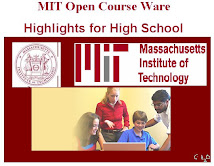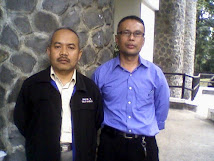Menggagas System Sekolah Bertaraf International
di Kota Banjar
“Suatu hari cucu-cucu kita akan harus pergi ke museum untuk melihat seperti apa itu kebodohan”
-H2O-
Kita harus berani bermimpi bahwa 8 tahun mendatang Kota Banjar mempunyai Sekolah International yang diakui Dunia
Bpk. Endang J. S.Pd., Bpk. Drs. Ahmad S., Bpk. Drs. Nanang S.
(SMAN 1 Banjar)

Arip Nurahman
(Indonesia University of Education & MIT Open Course Ware U.S.A.)


Abstract
An International school is loosely defined as a school that does not require their students to learn the national or local language of the country the school is located in. These schools cater mainly to students who are not nationals of the host country, such as the children of the staff of international businesses, international organizations, foreign embassies, missions, or missionary programs. Many local students attend these schools to learn the language of the international school and to obtain qualifications for employment or higher education in a foreign country. International schools can be both private, or public.
Introduction
Establishment
The first International schools were founded in the latter half of the 19th century in countries such as Japan, Switzerland and Turkey.[citation needed] Early International schools were set up with the help of nations having large interests in the hosting nation. An exception to this rule being Robert College in Istanbul.[citation needed]
Curriculum
International schools typically use curricula based on the school's country of origin. The most common international schools represent Education in the United Kingdom or Education in the United States. Many international schools use curricula specially designed for international school such as the International General Certificate of Secondary Education or the IB Diploma Programme. Like other schools, international schools teach the subjects such as language arts, mathematics, the sciences, humanities, the arts, physical education, information technology, and design technology. More recent developments specifically for primary school include the IBs Primary Years Programme (PYP) and the fast growing International Primary Curriculum (IPC).
Faculty
Faculties at International Schools are usually from or certified by the standards of their country of origin. However there are many exceptions. The most common exception is when the international school requires a teacher trained specifically for an international syllabus or for teaching a foreign language rare to the international school's country of origin. Hiring is frequently done at large international job fairs where schools can interview and hire several teachers at once.[citation needed]
Isi
Visi Sekolah Bertaraf Internasional (SBI), yaitu terwujudnya insan Indonesia cerdas, beriman dan bertakwa terhadap Tuhan Yang Maha Esa, berakhlak mulia, berjati diri Indonesia, dan kompetitif secara global. Merespon visi tersebut,
Upaya yang harus dilakukan dalam rangka memperbaki mutu sumber daya manusia adalah dengan meningkatan mutu pendidikan. Fokus utama yang harus perhatikan dalam peningkatan mutu pendidikan adalah peningkatan institusi sekolah sebagai basis utama pendidikan, baik aspek manajemen, sumber daya manusianya, maupun sarana dan prasarananya. Salah satu program yang dilaksanakan pemerintah agar perubahan dan perkembangan tersebut dapat direspon dengan cepat adalah dengan meningkatkan kualitas/mutu sekolah dengan mengembangkan sekolah bertaraf internasional.
Sekolah Bertaraf Internasional adalah sekolah nasional yang menyiapkan peserta didiknya berdasarkan standar nasional pendidikan (SNP)
1. Kompetensi lulusan,
2. Isi,
3. Proses,
4. Pendidik dan tenaga kependidikan,
5. Sarana dan prasarana,
6. Pembiayaan,
7. Pengelolaan,
8. Penilaian yang diperkaya, dikembangkan, diperluas, diperdalam melalui adaptasi atau adopsi terhadap standar pendidikan yang dianggap reputasi mutunya diakui secara internasional.
Aspek-aspek yang dikembangkan pada Sekolah Bertaraf Internasional adalah standar kompetensi lulusan standar Internasional, kurikulum standar internasional, PBM standar internasional, SDM standar internasional, fasilitas standar internasional, manajemen standar internasional, pembiayaan standar internasional, penilaian standar internasional.
Standar kompetensi lulusan Sekolah Bertaraf Internasional adalah keberhasilan lulusan yang melanjutkan ke sekolah internasional dalam negeri maupun di luar negeri dengan tetap berkepribadian bangsa
Mampu menyelesaikan, tugas–tugas dan mengumpulkan portofolio dengan baik, mampu meyampaikan/mendemonstrasikan tugas-tugas dari guru/sekolah, mampu melaksanakan eksprimen dalam pengembangan pengetahuan dan keterampilan, mampu menemukan / membuktikan pengalaman belajarnya dengan berbagai karya, mampu menulis dan mengarang dengan bahasa asing atau dengan bahasa Indonesia yang baik dan benar, memperoleh kejuaraan olimpiade internasional dalam bidang: matematika, fisika, biologi, kimia, stronomi, dan atau lainnya Iditunjukkan dengan sertifikat internasional),
NUAN rata-rata tinggi (> 7,5), memiliki kemampuan penguasaan teknologi dasar, melakukan kerjasama dengan berbagai pihak, baik secara individual, kelompok/kolektif (lokal, nasional, regional, dan global) dengan bukti ada piagam kerjasama atau MoU yang dilakukan oleh lulusan, memiliki dokumen lulusan tentang karya tulis, persuratan, administrasi sekolah, penelitian.
Mampu menguasai bahasa asing dan bahasa Indonesia yang baik dan benar, memiliki dokumen dan pelaksanaan, pengelolaan kegiatan belajar secara baik (ada perencanaan, pengorganisasian, pelaksanaan, pengkoordinasian, dan evaluasi) dari lulusan, menguasai budaya bangsa lain, memiliki dokumen karya tulis, nilai, dll tentang pemahaman budaya bangsa lain dari lulusan, memiliki pemahaman terhadap kepedulian dengan lingkungan sekitar sekolah, baik lingkungan sosial, fisik maupun budaya, memiliki berbagai karya-karya lain dari lulusan yang bermanfaat bagi dirinya maupun orang lain, bangsa, dan terdapat usaha-usaha dan atau karya yang mencerminkan jiwa kewirausahaan lulusan.
Sekolah Berstandar Internasional akan dicapai melalui sebuah proses peningkatan kualitas sekolah yang berkesinambungan. Salah satu tujuan pokoknya adalah lulusan sekolah yang kompetensinya diakui secara internasional. Proses peningkatan kualitas ini menyangkut semua komponen sekolah yang meliputi kegiatan belajar mengajar
Tulisan ini bertujuan untuk:
(1) Meningkatkan Mutu Tenaga Kependidikan Sekolah Bertaraf Internasional (SBI),
(2) Mengimplementasikan peran LPMP dalam program pengembangan Sekolah Bertaraf Internasional (SBI) pada sekolah-sekolah yang ditetapkan sebagai pilot project,
(3) Menyamakan persepsi di antara tenaga kependidikan tentang program pengembangan Sekolah Bertaraf Internasional (SBI),
(4) Menyusun rencana dan strategi program pengembangan Sekolah Bertaraf Internasional (SBI) berdasarkan kompetensi lulusan,
(5) Meningkatkan Mutu Pendidik Sekolah Bertaraf Internasional (SBI).
Education in developing countries
World map indicating Education Index
(according to 2007/2008 Human Development Report)
In some developing countries, the number and seriousness of the problems faced are naturally greater.[citation needed] People in more remote or agrarian areas are sometimes unaware of the importance of education. However, many countries have an active Ministry of Education, and in many subjects, such as foreign language learning, the degree of education is actually much higher than in industrialized countries; for example, it is not at all uncommon for students in many developing countries to be reasonably fluent in multiple foreign languages, whereas this is much more of a rarity in the supposedly "more educated" countries where much of the population is in fact monolingual.
There is also economic pressure from those parents who prefer their children making money in the short term over any long-term benefits of education.[citation needed] Recent studies on child labor and poverty have suggested that when poor families reach a certain economic threshold where families are able to provide for their basic needs, parents return their children to school.[citation needed] This has been found to be true, once the threshold has been breached, even if the potential economic value of the children's work has increased since their return to school.[citation needed] Teachers are often paid less than other similar professions.[citation needed]
A lack of good universities, and a low acceptance rate for good universities, is evident in countries with a relatively high population density.[citation needed] In some countries, there are uniform, over structured, inflexible centralized programs from a central agency that regulates all aspects of education.
- Due to globalization, increased pressure on students in curricular activities
- Removal of a certain percentage of students for improvisation of academics (usually practised in schools, after 10th grade)
India is now developing technologies that will skip land based phone and internet lines. Instead,
In
Internationalizations
Education is becoming increasingly international. Not only are the materials becoming more influenced by the rich international environment, but exchanges among students at all levels are also playing an increasingly important role. In Europe, for example, the Socrates-Erasmus Programme stimulates exchanges across European universities. Also, the Soros Foundation provides many opportunities for students from central
Kesimpulan dan Penutup
Kita tidak perlu takut untuk bermimpi dan berharap bahwasannya di Kota Banjar suatu hari nanti berdiri tegak sebuah sekolah international yang handal dan diakui dunia karena kualitasnya. permasalahnnya adalah bukan bisa atau tidak bisa tapi mau atau tidak mau dan Kita harus mau.
“KITA SUDAH LAMA TAKUT UNTUK BERMIMPI, SEKARANG SAATNYA MENGANYAM BENANG-BENANG HARAPAN ITU”
-H2O-
Hubungan
- Asian International School, Bali
- Bali International School
- Bandung Alliance International School
- Bandung International School
- Bandung Japanese School
- Bandung International School
- Batu Hijau International School,Ampenan
- Bogor Expatriate School
- Gandhi Memorial International School
- Green School, Kul-Kul Campus
- Hillcrest International School
- Manado International School
- Medan International School
- Mountainview International Christian School
- Sekolah Ciputra
- Semarang International School
- Surabaya European School
- Surabaya International School
- Wesley International School, Malang
- Yogyakarta International School
Menanti: Banjar International School, amin.
Referensi:
http://banjarcyberschool.blogspot.com/
^ educating - Definition from the Merriam-Webster Online Dictionary
^ UNESCO, Education For All Monitoring Report 2008, Net Enrollment Rate in primary education
^ Swassing, R. H., Barbe, W. B., & Milone, M. N. (1979). The Swassing-Barbe Modality Index: Zaner-Bloser Modality Kit.
^ Barbe, W. B., & Swassing, R. H., with M. N. Milone. (1979). Teaching through modality strengths: Concepts and practices.














